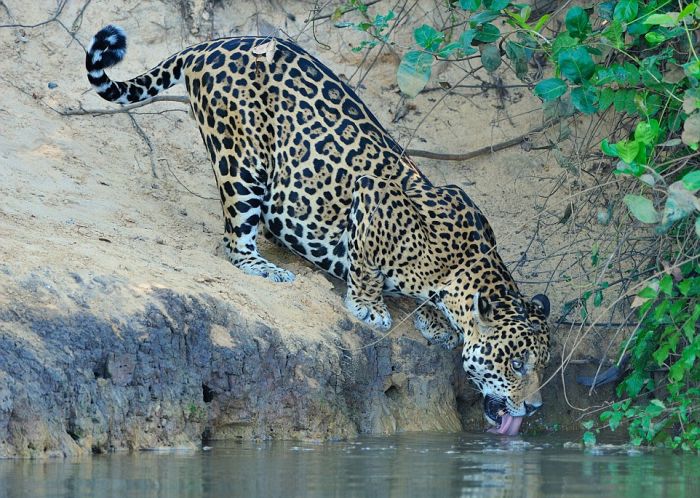|
|
Jaguar Hunts For A Crocodile
|
Further variations in size have been observed across regions and habitats, with size tending to increase from the north to south. A study of the jaguar in the Chamela-Cuixmala Biosphere Reserve on the Mexican Pacific coast, showed ranges of just about 50 kg (110 lb), about the size of the cougar. By contrast, a study of the jaguar in the Brazilian Pantanal region found average weights of 100 kg (220 lb), and weights of 136 kilograms (300 lb) or more are not uncommon in old males. Forest jaguars are frequently darker and considerably smaller than those found in open areas (the Pantanal is an open wetland basin), possibly due to the smaller numbers of large, herbivorous prey in forest areas.
A short and stocky limb structure makes the jaguar adept at climbing, crawling, and swimming. The head is robust and the jaw extremely powerful. The jaguar has the strongest bite of all felids, capable of biting down with 2,000 lbf (910 kgf). This is twice the strength of a lion and the second strongest of all mammals after the spotted hyena; this strength adaptation allows the jaguar to pierce turtle shells. A comparative study of bite force adjusted for body size ranked it as the top felid, alongside the clouded leopard and ahead of the lion and tiger. It has been reported that "an individual jaguar can drag a 360 kg (800 lb) bull 8 m (25 ft) in its jaws and pulverize the heaviest bones". The jaguar hunts wild animals weighing up to 300 kg (660 lb) in dense jungle, and its short and sturdy physique is thus an adaptation to its prey and environment. The base coat of the jaguar is generally a tawny yellow, but can range to reddish-brown and black, for most of the body. However, the ventral areas are white. The cat is covered in rosettes for camouflage in the dappled light of its forest habitat. The spots vary over individual coats and between individual jaguars: rosettes may include one or several dots, and the shapes of the dots vary. The spots on the head and neck are generally solid, as are those on the tail, where they may merge to form a band.
While the jaguar closely resembles the leopard, it is sturdier and heavier, and the two animals can be distinguished by their rosettes: the rosettes on a jaguar's coat are larger, fewer in number, usually darker, and have thicker lines and small spots in the middle that the leopard lacks. Jaguars also have rounder heads and shorter, stockier limbs compared to leopards.
|
|









